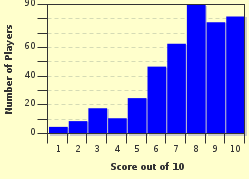Quiz Answer Key and Fun Facts
1. The first ball of the match, a fast bowler comes in at top speed and bowls a full toss at the batsman which just misses the batsman's head. What does the umpire do?
2. A batsman sweeps the ball and gets an edge, the wicket keeper misses the catch and the ball bounces off the wicket keeper's helmet which was behind the stumps and rolls over across the boundary line. How many runs are credited to the batting team?
3. A batsman is bowled off a no-ball, and both the bails fall off along with the leg stump. The batsman attempts to run a single, the wicket keeper collects the ball and hits the off stump, knocking it out of the ground. The batsman is out of his crease and the fielders appeal for a run out. What is the umpire's decision?
4. A batsman steps out to hit a spinner and misses the ball, the wicket keeper removes the bails. The decision is referred to the third umpire. The TV replays indicate the batsman's foot was on the line, what is the third umpire's decision?
5. The bowler bowls a delivery which is pitched outside the leg stump. The ball swings sharply and hits the batsman in front of his middle stump. An appeal is made for leg before wicket, what is the umpire's decision?
6. The batsman hits the ball in the air, the fielder near the boundary line catches the ball and loses his balance and falls over the boundary line. What is the umpire's decision?
7. The batsman drives the ball powerfully, it hits the bowler's hand and deflects on to the wickets at the bowler's end and dislodges the bails. The non-striker is out of his crease. What does the umpire do?
8. In the 1990s, a bowler while coming in to deliver a ball sees the non-striker trying to steal a single. Since the non-striker is out of crease, the bowler removes the bails and appeals for a run out. The same instance had repeated previously, but the bowler had not taken off the bails but only warned the non-striker. What does the umpire do?
9. A right hand off-spin bowler is bowling. In the middle of the over, he suddenly bowls left hand spin, the batsman is taken aback and is bowled. What is the umpire's decision?
10. The batsman hits the ball, it then hits his leg and rolls towards the stump. He immediately stops the ball with his bat. An appeal is made by the fielding side; what does the umpire decide?
Source: Author
deepakmr
This quiz was reviewed by FunTrivia editor
Nightmare before going online.
Any errors found in FunTrivia content are routinely corrected through our feedback system.

